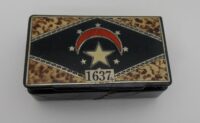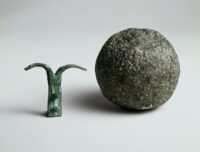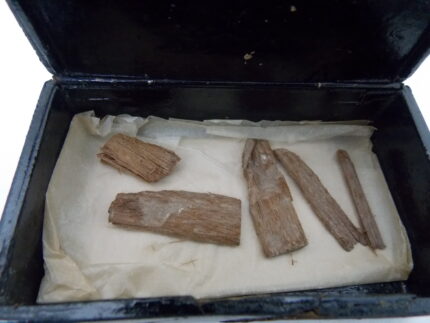 One of only three Egyptian artifacts ever found inside the Great Pyramid of Giza has been rediscovered after going missing for 70 years. The piece of cedar wood, now broken into several fragments, was recovered by Egyptian archaeologist Abeer Eladany in the Asia collection of the University of Aberdeen. She came across a small box bearing the former flag of Egypt during a curatorial review of objects in storage. She cross-referenced it with the records of the University’s Egyptian objects and recognized it as the long-lost Great Pyramid cedar, misplaced for decades in the wrong collection.
One of only three Egyptian artifacts ever found inside the Great Pyramid of Giza has been rediscovered after going missing for 70 years. The piece of cedar wood, now broken into several fragments, was recovered by Egyptian archaeologist Abeer Eladany in the Asia collection of the University of Aberdeen. She came across a small box bearing the former flag of Egypt during a curatorial review of objects in storage. She cross-referenced it with the records of the University’s Egyptian objects and recognized it as the long-lost Great Pyramid cedar, misplaced for decades in the wrong collection.
The cedar was found in the “Queen’s Chamber” (a misnomer as Khufu’s wives were buried in their own pyramids in the complex; a niche in the east wall may have held Khufu’s ka statue, eternal resting place of the pharaoh’s soul) by British shipbuilding engineer Waynman Dixon in 1872. He was looking for shafts that connected the chamber in the center of the pyramid to the outside walls like the two that go up in a v-shape from the King’s Chamber. He almost succeeded, finding two air shafts in the same v-shape, although they don’t quite reach the outer walls. In one of the shafts Dixon found a spherical pounder of black diorite, a copper forked implement shaped like a swallow’s tail and a wood board.
 It’s not clear what uses they were put to and why they were left in the shaft. The copper object has organic remains suggesting it once had a bone handle. They may have been tools used in construction of the pyramid left behind by builders, or they may have been deliberate deposits with ritual purpose.
It’s not clear what uses they were put to and why they were left in the shaft. The copper object has organic remains suggesting it once had a bone handle. They may have been tools used in construction of the pyramid left behind by builders, or they may have been deliberate deposits with ritual purpose.
These sole survivors of centuries of looting of the Great Pyramid made headlines at the time of their discovery. In the 1972, the pounder and the copper tool were donated to the British Museum. The cedar plank was donated to the University of Aberdeen in 1946 by the daughter of James Grant, a medical doctor who had worked with Dixon on the exploration of the Queen’s Chamber shafts.
The rediscovery of the cedar is of special interest because it can be radiocarbon dated. Testing was delayed by COVID, but is now complete and it has revealed that the cedar wood fragment is so ancient it makes the Great Pyramid look like a baby. It dates to between 3341-3094 B.C, at least 500 years before construction of the pyramid which was completed around 2560 B.C.
Neil Curtis, Head of Museums and Special Collections at the University of Aberdeen, said: “Finding the missing Dixon Relic was a surprise but the carbon dating has also been quite a revelation.
“It is even older than we had imagined. This may be because the date relates to the age of the wood, maybe from the centre of a long-lived tree. Alternatively, it could be because of the rarity of trees in ancient Egypt, which meant that wood was scarce, treasured and recycled or cared for over many years.
“It will now be for scholars to debate its use and whether it was deliberately deposited, as happened later during the New Kingdom, when pharaohs tried to emphasise continuity with the past by having antiquities buried with them.”

Still no cigar!
I wood say it was more of a board than a plank.
I once left a 10 pence coin on the rafter of the garage where I used to work, while cleaning the overhead power system. I only worked there for four years, so if you had spent your working lifetime building a pyramid you might want to leave something there, as an informal ‘topping out’ ceremony.
Really? ..A pyramid, hookers, wood and only one stone ball –Oh Osiris! However, diorite is considerably harder than their usual copper chisels, and it may have played a certain role in ancient stone cutting. Those hooks also do look like some form of tool to me, but as far as the wood is concerned, I hardly imagine a tool lasting for 500+ years. Note that our wooden hatch to the attic is operated with very similar hooks on a broomstick.
The board could have been a ‘collector’s item’ that the pharaoh urgently needed in the afterlife. Maybe coffins were made from really old wood, like some violins occasionally are, I am told. My late grandpa had splinters on his wall, which exactly looked like those fragments, but with a brass plaque insinuating “Cutty Sark”. Moreover, the Lebanon ‘Cedar Forest’ is mentioned in the Epic of Gilgamesh.
:hattip:
The hammer stone is the prize. We think of them more for knapping but they were just as useful for smoothing softer stone.